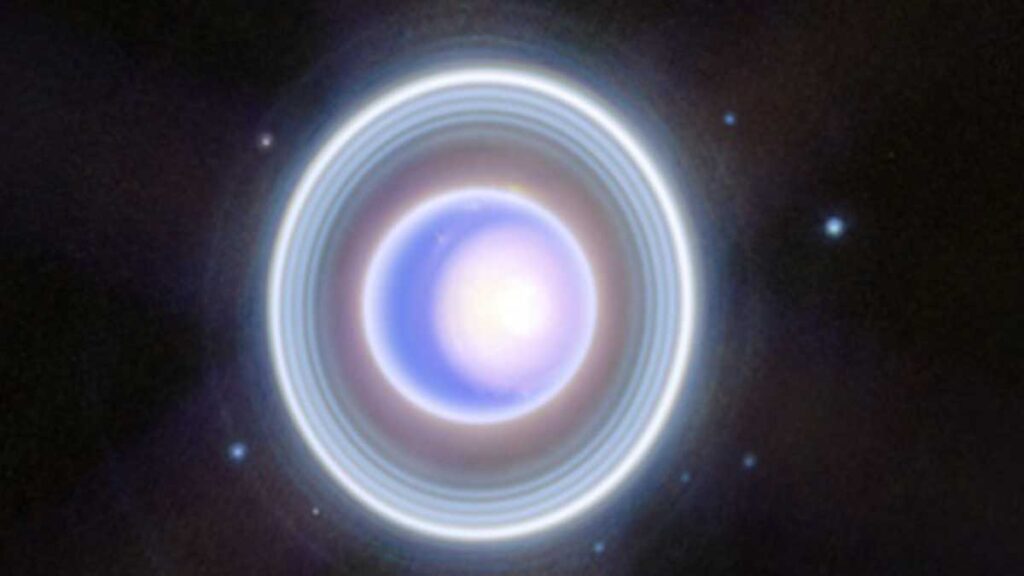
NASA’s Webb Rings in Holidays With Ringed Planet Uranus
As the holiday season fills the air with cheer and twinkling lights, NASA’s James Webb Space Telescope has delivered a celestial gift: a stunning portrait of the distant ice giant Uranus, adorned in its magnificent ring system. This unprecedented view, captured in infrared wavelengths, showcases a dynamic world unlike any other in our solar system.
Uranus, the seventh planet from the Sun, holds the distinction of being a true oddball. Unlike most planets that spin upright on their axes, Uranus is tipped over on its side, orbiting the Sun like a giant rolling bowling ball. This unique tilt, along with its immense distance from the Sun, shrouds the planet in perpetual twilight and mystery. But Webb’s powerful infrared gaze has pierced through the darkness, revealing a treasure trove of new insights about this enigmatic world.
The most captivating aspect of Webb’s image is undoubtedly the intricate ring system surrounding Uranus. Previously, only two faint, dusty rings were known to exist. However, Webb’s infrared vision has unveiled a dazzling menagerie of ten previously hidden rings, some as narrow as a few kilometers wide. These rings, composed of icy particles and dark organic material, shimmer like celestial confetti around the planet, adding a touch of cosmic elegance to its portrait.
But the rings are just the beginning of the wonders Webb has brought to light. The image also reveals a vibrant tapestry of colors across Uranus’s atmosphere. The planet’s signature blue hue, caused by the absorption of sunlight by methane gas, is evident at the poles. However, Webb’s infrared sensitivity detects subtle variations in this color, hinting at the presence of complex atmospheric dynamics and weather patterns. Additionally, faint reddish streaks can be seen near the equator, suggesting the presence of deeper atmospheric layers containing hazes and aerosols.
Furthermore, Webb’s observations have identified several dark, storm-wracked spots dotting the planet’s surface. These features, likely driven by the intense internal heat radiating from Uranus’s core, provide clues about the planet’s hidden internal processes and its powerful winds. One particularly prominent storm, nicknamed the “Dark Spot Jr.,” stands out against the backdrop of swirling clouds, promising a deeper understanding of the planet’s turbulent weather systems.
Beyond the planet itself, Webb also captured two of Uranus’s moons in its field of view: Ophelia and Puck. These moons, like miniature versions of their parent planet, exhibit their own unique colors and features. Ophelia, the brighter of the two, appears as a pale blue dot with a hint of a dark ring around its equator. Puck, on the other hand, is a fainter, grayish speck, offering a tantalizing glimpse into the diversity of celestial bodies orbiting Uranus.
The scientific implications of Webb’s observations of Uranus are far-reaching. By studying the composition and distribution of its rings and atmospheric features, astronomers can gain valuable insights into the planet’s formation and evolution. Additionally, understanding the complex interplay between Uranus’s tilt, rings, and atmosphere could hold the key to unlocking the secrets of other tilted planets, both within our solar system and beyond.
In conclusion, NASA’s Webb Space Telescope has gifted us with a truly awe-inspiring view of Uranus, unveiling a world far richer and more complex than we ever imagined. This holiday season, as we gather with loved ones and marvel at the twinkling lights, let us also take a moment to appreciate the breathtaking beauty and mysteries of the universe revealed by this incredible scientific instrument. Webb’s observations of Uranus are just the beginning of a new era of exploration, promising to rewrite our understanding of ice giants and reshape our vision of the cosmos. So, let the festive spirit carry us forward, filled with wonder and anticipation for the next celestial treasure Webb will unveil.





